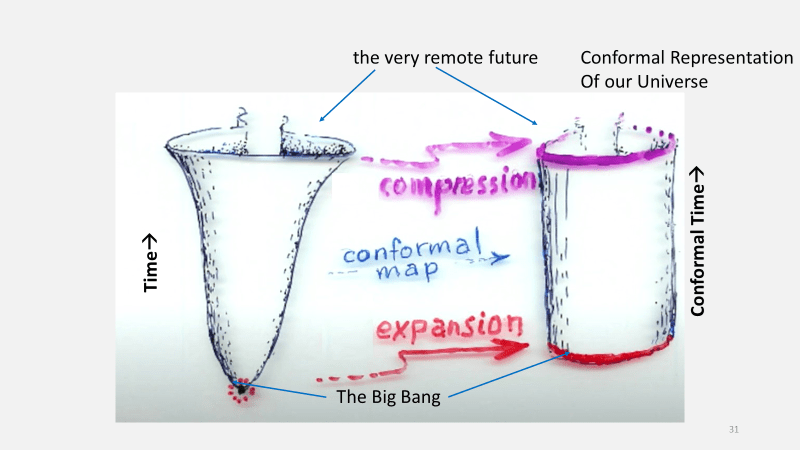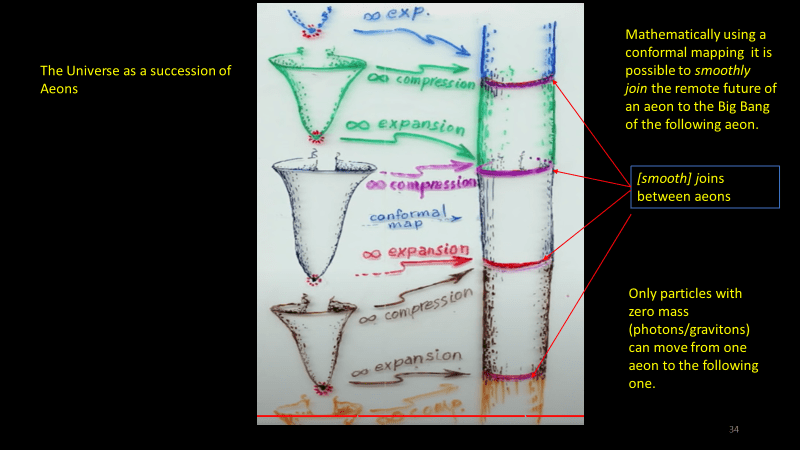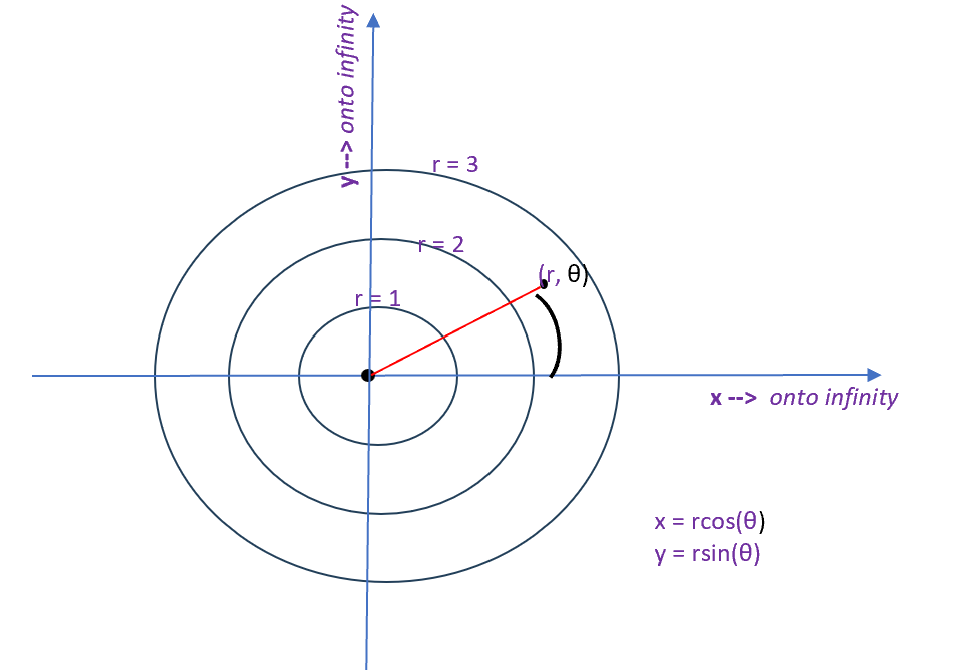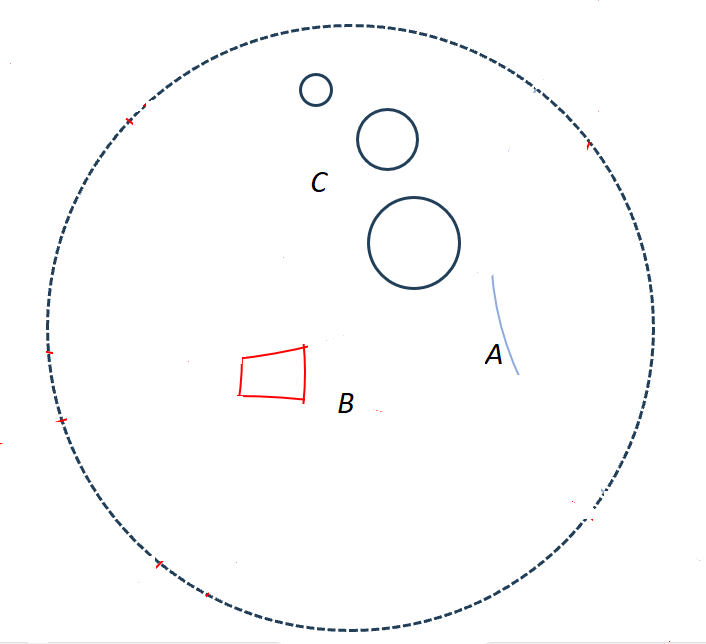In my last post I remarked on the surprising similarity between conditions in the very early Universe, just after the Big Bang, and the far future of the Universe. In this post I’ll give an overview of Roger Penrose’s model of the Universe in which it passes endlessly through a possibly infinite number of cycles (or aeons) each of which starts with a Big Bang and ends with a rapidly expanding empty universe. This is known as conformal cyclical cosmology (CCC) and is described in much more detail in his book Cycles of Time.
Conformal Mappings
Penrose’s idea makes use of something called a conformal mapping. This is a mapping from one set of coordinates to another which preserves the angles at which lines meet and the shapes of infinitesimally small objects, but the sizes of objects are not preserved. Conformal mapping, which had previously been in the realm of abstract mathematics, was made popular in the mid-twentieth century in drawings by the Dutch artist MC Escher. If you look at this picture it shows how an infinite plane can be mapped into a finite area.

Circle limit III ME Escher(1959)
If we imagine an infinite plane covered in fish of the same size and shape, we can conformally map the infinite plane onto a circle. The boundary of the circle represents infinity. The fish retain their shapes but not their sizes and get smaller and smaller as the boundary of the circle approaches. For the more mathematically inclined, I have put some notes about this conformal mapping at the bottom of this post.
Timeline of the Universe
Now let’s look at the diagram below. It shows how the scale of the Universe changes over time.

The vertical axis shows time running from t=0 (the exact instant of the Big Bang) to the remote future The horizontal axis represents “the scale of the Universe”. The diameter of the observable Universe we see today is 92 billion light years. If we extrapolate backwards, at the exact instant of the Big Bang 13.8 billion years ago, the diameter of this region would be zero – assuming that the laws of physics still apply at such extreme conditions. If we extrapolate to the far future, then this region will expand exponentially getting larger and larger. .
Conformally mapping the Universe
What Penrose does is to conformally map the entire Universe from t = 0 when it has zero volume to t = infinity when it has infinite volume. The Escher picture we’ve seen previously is a conformal mapping of two dimensional space, whereas Penrose uses a conformal mapping of the three spatial dimensions and one time dimension. This mapping of four dimensions (three space and one time) cannot be easily drawn in a two-dimensional drawing. So, one of the spatial dimensions is not shown. The diagram below shows how Penrose’s conformal mapping works. On the left-hand side, we have the picture showing the evolution of the Universe. The right-hand side shows a conformal representation of the Universe.

The conformal mapping is defined so that as the Universe expands and its scale increases its conformal scale remains the same. So, near the Big Bang, the Universe is conformally stretched by a large factor. Whereas, in the remote future, the Universe is conformally compressed by a large factor.
If we imagine two galaxies which are a long distance away from each other the distance between them will increase over time due to the expansion of the Universe. However, the conformal distance between them doesn’t change. In addition, although time runs from zero (the Big Bang) to infinity, in the conformal mapping a time of infinity is mapped on to a finite conformal time. The mathematics of how this is done is much more complex than the conformal mapping of two spatial dimensions and If you want to find out more click here

Multiples aeons
If we look at the far future of our Universe, after an extremely long time (greater than 10100 years) all massive particles will have decayed. The only particles in the Universe will be photons and gravitons (hypothetical particles which carry the force of gravity). Photons and gravitons have zero rest mass, travel at the speed of light and, from Einstein’s theory of special relativity, anything travelling at the speed of light does not register the passage of time. So, in a sense the Universe “loses track of time”. As the Universe continues to expand the density of photons and gravitons falls and the universe is essentially empty apart from dark energy . Its temperature will get closer and closer to the lowest possible temperature – absolute zero.
The clever bit is that, if we take Penrose’s conformal representation of the far future of the Universe, it can be smoothly joined to the conformal representation of the Big Bang at the start of another universe which follows our own. At the point of the join, the distance scale is squashed massively. The very low temperatures and densities (of massless particles) in the far future of our universe become equivalent to very high temperatures and densities in the new distance scale of the subsequent universe.
Penrose suggests that this subsequent universe will have the same laws of physics as our universe and so it too will begin with Big Bang and end with the exponential expansion of a universe containing only massless particles and dark energy.
The conformal representation of the far future of the subsequent universe can be smoothly joined to the conformal representation of the Big Bang at the start of another universe which follows it. This next universe will also have the same laws of physics and will also begin with a Big Bang and end with an exponential expansion of a universe containing only massless particles and dark energy
The process can be carried out an infinite number of times. Each cycle of a universe starts with a Big Bang and ends in the exponential expansion of an essentially empty universe which can be smoothly mapped onto the Big Bang of the following cycle. Penrose calls each cycle an aeon and all aeons have the same laws of nature, which is why every aeon has the same ultimate fate. This does not mean that all aeons have exactly the same history. The detail of what happens in a particular aeon is due to chance.

In our aeon, after the Universe was roughly 9 billion years old, the Solar System formed in an outer region of the Milky Way galaxy. The Solar System had eight planets. On the third planet from the Sun, after it had cooled down enough for water to exist in the liquid form, primitive life forms emerged. Eventually, four billion years later, intelligent life evolved which developed into a planet wide civilisation (humanity!)
Is CCC correct?
This theory addresses some of the problems with the standard Bing Bang theory. These include.
- Was the Big Bang really a singularity (a place of infinite density where the laws of physics break down)?
- What caused the Big Bang?
- “The horizon problem” Why do different regions of space, which haven’t had time to come into contact with each other, since the Big Bang, look the same?
Even though CCC addresses these questions, it doesn’t mean it is correct. The mathematics behind CCC is consistent, but that doesn’t mean that it reflects the real world. CCC might be an abstract mathematical curiosity which bears no resemblance to reality.
A good scientific theory is one which makes predictions which can be experimentally tested and if these predictions are fulfilled the theory is supported, if not the theory is falsified. The Steady State theory in which the Universe taken as a whole does not evolve or change over time was very popular in the late 1940s and 1950s is a good theory. The theory was shown to be incorrect in the 1960s when it became clear that the Universe is changing. Even so, in the words of Stephen Hawking:
‘the Steady State theory was what Karl Popper would call a good scientific theory: it made definite predictions, which could be tested by observation, and possibly falsified. Unfortunately for the theory, they were falsified’
If CCC is correct , Penrose predicts there should be bright spots in the microwave background . These are known as Hawking points and are caused by the evaporation of supermassive black holes in the previous aeon by Hawking radiation (discussed in a previous post. The photons from such evaporating black holes can crossover into our aeon. If these Hawking points were ever found it would provide strong support for CCC. Another predicted feature is concentric circles caused by the emission of gravitational radiation by the collision of supermassive black holes in the previous aeon.
Although some believers of CCC have published scientific papers claiming that such features do exist, the consensus among the vast majority of astronomers who have studied microwave background surveys is that no examples of these features have been found. Previous claims of such detections have been due to errors in the data analysis ( https://arxiv.org/abs/2208.06021). Therefore, the general view is that no evidence has been found to support CCC. However, this does not necessarily mean CCC is incorrect. It remains a possibility that such features might exist but could be weaker that we can currently detect.
It will be interesting to see how things develop over the next few years. Cosmic inflation (which I’ll talk about in a later post) is much more widely-believed alternative to CCC.
—————————————————————————————————————–
Example of a conformal mapping in two dimensions
Consider an infinite plane, then any point on the plane may be represented by polar coordinates (r, θ) where r is the distance from the origin and θ is the angle from the x-axis.

The infinite plane can be conformally mapped onto a circle which has radius =1 by defining new coordinates (R, Θ) where R = (er -1) / (er +1) and Θ = θ.
The diagram below shows how the infinite plane looks after the mapping. The boundary of the circle where R = 1 corresponds to a value of r = infinity

It can be shown (but I won’t do it here 😉) that the angles between any two lines are preserved by the conformal mapping from (r, θ) to(R, Θ). In general shapes are not preserved and become distorted distorted. The larger the shape the greater the distortion.

Some examples of how shapes are changed after the mapping.
- A straight line which does not pass through the origin becomes curved (A)
- The sides of a rectangle are distorted into curves (B)
- The shapes of circles are not distorted and remain as circles– but their sizes change. (C) shows how three circles of the same size appear after the mapping. The further the circle from the origin the smaller it is
Penrose diagrams
One earlier use of conformal mappings, long before CCC was developed, is in Penrose diagrams. These were developed by Roger Penrose in the 1960s. They use a conformal mapping to show an infinite range of space and time on two-dimensional diagram and are very useful tools in cosmology. For more details on Penrose diagram see

[…] Fuente del artículo […]
LikeLike
In a singularity supposedly nothing ever happens and I wonder how something could arise from it.
LikeLike
Thank you Margaret. I hope the post makes sense!
LikeLike
In parts! Then you said it was just another good theory and might be proved totally wrong…..love that about science!
LikeLike
Steve, thank you very much for writing this post. Do you know if there have been any attempts to show equivalence between CCC and cosmic inflation?
LikeLiked by 1 person
Thank you Steve,
I am planning to write a post about inflation later.
CCC and inflation aren’t really equivalent and should be seen as alternative theories to explain some of the issues with the original Big Bang theory of the origin of the Universe. In general, inflation is the preferred theory and CCC has been largely ignored by most cosmologists. One of the issues with CCC (which Penrose goes into detail in his book and I’ve glossed over in this post) is that it requires all massive particles to decay eventually to massless particles. This is not part of standard particle physics
LikeLiked by 1 person
Cycles of time is a very a heavy read BUT
The following video, made in 2018, gives a good overview of CCC
LikeLike